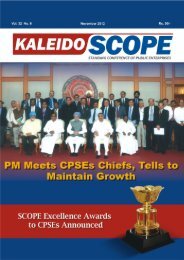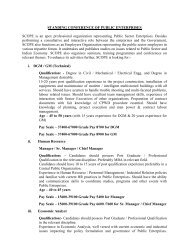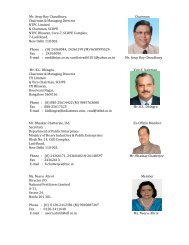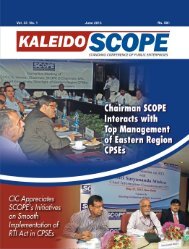Skill Development - scope
Skill Development - scope
Skill Development - scope
You also want an ePaper? Increase the reach of your titles
YUMPU automatically turns print PDFs into web optimized ePapers that Google loves.
<strong>Skill</strong>ing India to Growth Path-<br />
PSEs Partnering with Government<br />
Dr. U. D. Choubey<br />
Director General, SCOPE<br />
Dr. U. D. Choubey<br />
PSEs have incorporated 3 P’s<br />
i.e. People, Planet and Profit,<br />
within its work ethics. People<br />
come foremost for them and<br />
hence, they have given major<br />
thrust to human resource<br />
management time and again<br />
by adopting training and development<br />
of the workforce in<br />
order to enhance their skills. It<br />
is carried out in diverse ways<br />
including on the job training,<br />
in-house training programs,<br />
participation in external exposures<br />
etc.<br />
<strong>Skill</strong>s and knowledge are the<br />
crucial driving forces for a<br />
sustained economic and social<br />
development of any country.<br />
Given the increased globalization<br />
and dynamic technical environment,<br />
the need for constant<br />
upgradation and development<br />
of skills and knowledge has also<br />
increased.<br />
In various studies, it has been<br />
observed that countries with<br />
higher and better levels of skills<br />
adjust more effectively to a fast<br />
changing environment. Further,<br />
there is an increased awareness<br />
amongst policy-makers that for<br />
their countries to be able to compete<br />
with developed countries<br />
they must produce a higher value<br />
added and quality goods/ services<br />
that can yield higher wages<br />
and profits. To do this they need<br />
a skilled workforce and an education<br />
and training system that adequately<br />
prepares young people<br />
to enter the labour market.<br />
For this reason need for skills development<br />
and knowledge upgradation<br />
is attracting heightened<br />
interest in many countries.<br />
Over the years India has gradually<br />
evolved as a knowledge-<br />
based economy due to various<br />
factors foremost being abundance<br />
of human capital. As compared<br />
to western economies where<br />
there is a burden of an ageing<br />
population, India has a unique<br />
20–25 years window of opportunity.<br />
This is apparent from the fact<br />
that out of a population of 1.21<br />
billion 1 in the year 2011, more<br />
than 50 percent of the population<br />
was in the age group of 15 to 59<br />
years which is usually termed<br />
as the ‘working age population’.<br />
Further, according to Census<br />
Board of India, presently 40 percent<br />
of the population is below<br />
the age of 18 years and by 2015 it<br />
is expected that 55 percent of the<br />
population would be below age<br />
of 20 years. This gives rise to ‘demographic<br />
dividend’ to India i.e.<br />
as compared to other large developing<br />
and developed countries;<br />
India has a higher proportion of<br />
working age population vis-à-vis<br />
its entire population. In addition,<br />
a shortage of approximately<br />
56 million skilled manpower by<br />
the year 2020 is expected in the<br />
global economy.<br />
However, aforesaid ‘demographic<br />
dividend’ can easily turn<br />
into a disaster if unemployment<br />
1<br />
As per ‘Educational Statistics at a Glance’ published by Bureau of Planning, Monitoring &<br />
Statistics, Ministry of Human Resource <strong>Development</strong>, Government of India<br />
20 Kaleido<strong>scope</strong> July 2013













